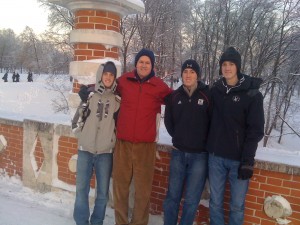
Brooke boys and Russian friends Polina and Julia pause from skating on Red Square on Russian Orthodox Christmas Eve
Kremlin leaders regularly say they want to increase tourism in order to diversify a Russian economy that is overly dependent on oil and gas. Tourism is labor intensive, geographically dispersed, and carries the potential to promote trade and investment.
That may sound like a good plan, but Russia’s bureaucracy doesn’t always cooperate.
As an accredited foreign correspondent, I was told that my three sons could come and go as they pleased. In reality, that meant paying $140 for each son’s single entry, eight-day work visa. The fact that my sons are college students and had no intention of working during their week in Moscow was ignored. Then there was the visa form with questions that seem designed give visitors second thoughts about visiting Russia.
Question 30: “Do you have any specialized skills, training or experience related to firearms and explosives or to nuclear matters, biological or chemical substance? If yes, please specify.”
Forms filled out, money orders purchased, the boys — James, 20, William, 18, and Alexander, 18 — encountered a new obstacle at the Russian Consulate in New York.
Alexander said on a phone call: “To get the Russian visa, they say we have to get AIDS tests.”
I checked around. Mike, an American executive here who shares my stinginess, had a suggestion: “No sweat, just send them uptown to get a free AIDS test. Just don’t tell them it’s for a visa or they won’t do it.”
Three AIDS tests at a Harlem clinic later, $420 paid to the Russian consulate, and the boys were winging their way toward Moscow.
Once here, they briefly joined a community of about 5,000 Americans registered with the American embassy as living in Russia.
On the flip side of the coin, there are an estimated 5-million Russian speakers now living in the United States.
Echoes of this 1,000 to one ratio can be seen in Europe.
Eager for tourism, France last year gave visas to about 300,000 Russians and Spain gave visas to 445,000. Finland stamped a record 1-million visas for Russians. To pep up the economy of Northern Norway, Oslo has started a visa-free regime for residents of neighboring Russian regions. Last year, 140,000 Russians crossed the border. During Russia’s recently completed 10-day New Year holiday, 25,000 Russians swarmed into Arctic Norway and Finland.
But while the Finnish and Spanish consular officials stamp Russian passports like whirling dervishes, tourist traffic going the other way is barely a trickle. Carlos, a Spanish television correspondent here, says the Russian visa process in Madrid takes three weeks and 200 Euros. He guesses that at best 20,000 Spaniards visited Russia last year.
Once here, there is a lot to see and do. My sons skated on Red Square, sat in the captain’s chair of a submarine moored in the Moscow River, walked through the snow covered grounds of the Tsaritsyno estate, visited the modern art exhibitions at Garazh, and watched men with chainsaws shape sculptures from ice.
It was fun. But given the inertia of Russian bureaucracy, I’m not holding my breath for the visa process here to get any easier.
For the next family reunion, we can meet in Helsinki or Kiev, which also have direct flights from New York. American tourists don’t need visas for Ukraine or Finland. For that matter, American tourists don’t need visas for most of Russia’s neighbors, including Japan, Mongolia, Georgia, Poland, Lithuania, Latvia, Estonia, and Norway. Instead of spending $420 on Russian visas, I’ll put that money into hotels, restaurants and museums somewhere else. That way, Moscow’s bureaucratic inertia can help diversify another country’s economy.




One response to “My Sons’ Road To Russia Passed Through A Harlem AIDS Clinic”
What Kremlin leader has ever said anything about tourism? Let alone regularly?